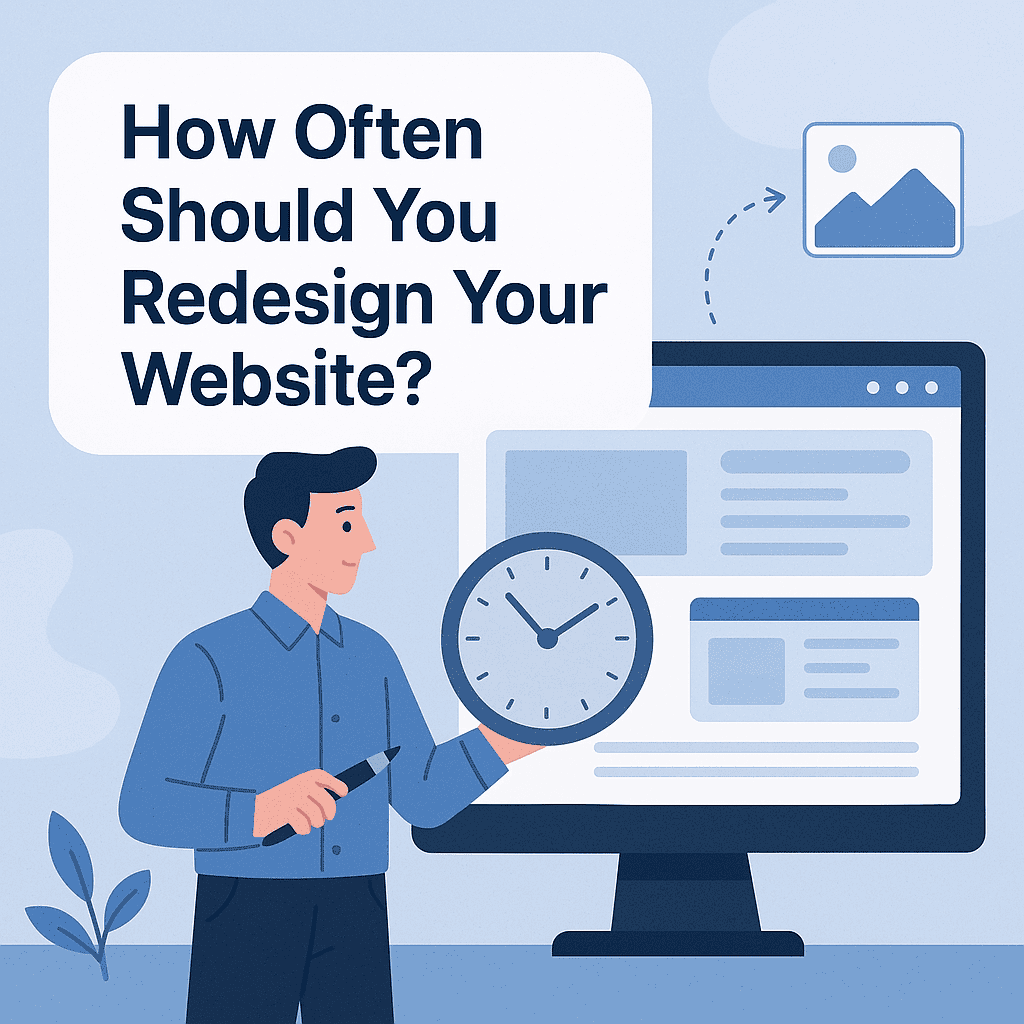In the fast-paced digital world, having a well-designed website isn’t just about aesthetics—it’s about functionality, brand credibility, user experience, and staying competitive. Whether you’re running a startup, a local business, or an established enterprise, your website is often the first interaction a customer has with your business.
If your current design isn’t delivering the experience your users expect, or if your backend systems aren’t keeping up with performance demands, it might be time to explore website redesign services. But how often is too often—and how do you know when it’s the right time?
Let’s dive into data-backed insights and real-world triggers that signal it’s time to refresh or redesign your website.
The Average Website Lifespan: 2 to 3 Years
Most experts and agencies agree that the average lifecycle of a modern website is 2 to 3 years. This is echoed across many reputable sources, including FMG Suite, Sachs Marketing Group, and Walker Sands.
Why that timeframe?
Because in 2 to 3 years, technology evolves, design trends shift, and user expectations grow. What looked great and functioned well in 2021 may already feel outdated by 2024.
Key Drivers of This Lifespan:
- Changes in branding or business strategy
- Mobile and browser compatibility updates
- SEO algorithm changes
- Page speed and performance optimization needs
- Evolving customer behavior and UX expectations
Signs That It’s Time for a Website Redesign
Instead of focusing strictly on the calendar, it’s smarter to evaluate your website based on performance and usability. Below are common signs that indicate a redesign may be necessary.
-
Outdated Design Aesthetics
Web design trends evolve rapidly. What once looked modern and clean might now feel cluttered, dated, or visually off-brand.
Tip: Compare your site to competitor sites launched within the last year. If yours doesn’t stack up visually, it’s time for a refresh.
-
High Bounce Rates and Low Engagement
If users are landing on your site but quickly leaving without exploring more pages, there could be UX or design flaws pushing them away.
Check:
- Bounce rate
- Time on site
- Click-through rate (CTR) on buttons and CTAs
-
Poor Mobile Responsiveness
With over 60% of global web traffic coming from mobile phones, responsive website design is not optional—it’s essential. If your site doesn’t perform well across screens, your rankings and conversions are likely suffering.
-
Declining Search Engine Rankings
SEO and website structure go hand-in-hand. Outdated sites that lack schema markup, fast load times, or crawl-friendly architecture can fall behind.
Indicators:
- Dropping keyword rankings
- Fewer indexed pages
- Increased crawl errors in Google Search Console
-
Slow Load Times
Modern users expect fast, seamless experiences. If your site doesn’t load in 2–3 seconds, you’re likely losing traffic.
Tools to test speed:
- Google PageSpeed Insights
- GTmetrix
- WebPageTest
Business-Driven Reasons to Redesign Your Website
Redesigning isn’t always about poor performance. Sometimes, your business evolves—and your website needs to catch up.
-
Rebranding or New Positioning
Whether you’re targeting a new audience, entering a new market, or updating your brand identity, your website must reflect that change.
-
Launching New Products or Services
Adding new services or product lines? Your website should be structured to accommodate and promote them effectively.
-
Switching Platforms or CMS
Migrating to a more scalable or flexible CMS (like WordPress, Webflow, or a headless solution) is often the right move—and it often calls for a redesign.
-
Need for Custom Features
Out-of-the-box solutions might no longer meet your needs. Custom web development can build scalable tools (such as booking systems, CRMs, or portals) directly into your redesigned website.
What to Expect from a Modern Website Redesign
Redesigning a website isn’t just about making it look good—it’s about making it work better, smarter, and more efficiently.
Here’s What a Strategic Redesign Typically Includes:
- Improved UX/UI design based on data and behavior
- Faster performance across devices and browsers
- Mobile-first approach with responsive website design
- SEO optimization and structured metadata
- Integration of third-party tools (CRM, analytics, email)
- Accessible navigation and WCAG compliance
- Scalable and maintainable custom web development
At Website Legends, our website redesign services focus on results—ensuring every pixel and every line of code serves your business goals.
How Often Should Your Business Redesign?
Let’s get personal. While 2–3 years is a general rule, here’s how to determine your own timeline based on specific factors:
| Scenario | Redesign Frequency |
| Fast-growing startup | Every 1–2 years |
| Local service business | Every 2–3 years |
| SaaS or tech platform | Every 1–2 years |
| Nonprofits or static sites | Every 3–5 years |
| Ecommerce stores | Every 1–2 years or per major platform upgrade |
Evaluate your traffic data, business goals, and current site performance to identify whether it’s time to refresh your design—or overhaul it completely.
Website Refresh vs. Redesign: What’s the Difference?
Not every website needs a full-scale redesign. Sometimes, a targeted refresh is enough.
Website Refresh:
- Updating colors, fonts, and visuals
- Improving key landing pages
- Replacing outdated content
- Adding new images and media
Full Website Redesign:
- Rebuilding site architecture
- Overhauling UX and responsive design
- Switching CMS or backend technology
- Redefining brand experience across the site
Consult with your developer or digital strategist to determine which path is right for your brand.
Best Practices When Planning a Redesign
-
Set Clear Goals
What do you want the new site to achieve? More leads? Faster performance? Better UX? Set measurable KPIs before the project begins.
-
Involve Stakeholders Early
From marketing to sales to IT—get everyone’s input on what’s working and what needs improvement.
-
Audit Existing Performance
Use Google Analytics, Search Console, and heatmap tools to identify what’s already performing well—and what’s not.
-
Prioritize SEO From the Start
Use proper 301 redirects, preserve high-ranking content, and work closely with an SEO specialist during migration.
-
Choose the Right Team
Whether in-house or via an agency, make sure your team includes UX designers, front-end/backend developers, and SEO strategists.
Conclusion
A website isn’t just a digital brochure—it’s the engine of your brand’s online presence. If it’s not aligned with your goals, delivering on user expectations, or optimized for search, then it’s time for a change.
The best approach? Redesign intentionally—guided by data, shaped by strategy, and powered by experts. At Website Legends, our website redesign services, custom web development, and responsive website design solutions are tailored to deliver not only beautiful sites but also high-performing digital experiences.
So, how often should you redesign your website?
Every time, it stops working as hard as you do.


